This was the second year in which we spent several months wandering as
gypsies in our 5th-wheel trailer.
Our scheduling this year was to attend Al's 50th year high school reunion,
reunite with Gail's college roommate, attend a five-class reunion
of Gail's grade school, and participate in our annual reunion with the
clan of former co-workers at the University of Minnesota.
Like last year we began with a short excursion to the Washington DC/Capitol KOA
in Millersville, MD, to check out the equipment and our skills after an idle winter.
Doug and his family visited us there for dinner and for bouncing on the neat
giant pillow on the playground.
|
We left home on June 27 and travelled north to Jersey City. Not exactly a
wilderness area, but we wanted to visit with CJ in Brooklyn before we headed west.
The closest RV park to Brooklyn is the
Liberty Harbor RV Park and Marina in Jersey
City. It has a great location, just five blocks from a Port Authority station for
the train to the World Trade Center. The location of our camping site wasn't quite so
good. It had a light pole smack in the middle of the entrance to the site. With a lot
wiggling back and forth, we managed to get the Moving House in place without
hitting the Class B camper on one side or the travel trailer on the other
side, and without bumping the bicycles on the rack of the RV behind us.
We had a good time visiting CJ. We saw a rehearsal by CJ and three other dancers
for a performance coming up on July 15. We toured Lower Manhattan, seeing
Battery Park and
Castle Clinton
there, the financial district and Zuccotti Park
and other sites important to the Occupy movement. We heard a concert by
Fishbone,
and looked at lots of art on the 5th floor of the Brooklyn Museum,
where there was a special exhibit of art by
Keith Haring.
The peak temperatures were uncomfortably near 100 while we were
in New York. Good for having air conditioning in the Moving House and
for visiting the Zeppelin Hall Beer Garden near our campground.
|
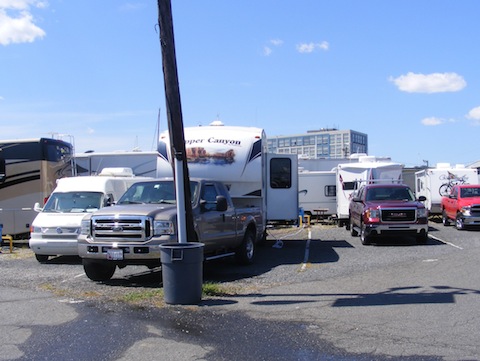
|
CJ and Gail on the Promenade in Brooklyn
|
The Sphere, a sculpture damaged on Sept 11, 2001,
with the New World Trade Center towers rising in the background
|
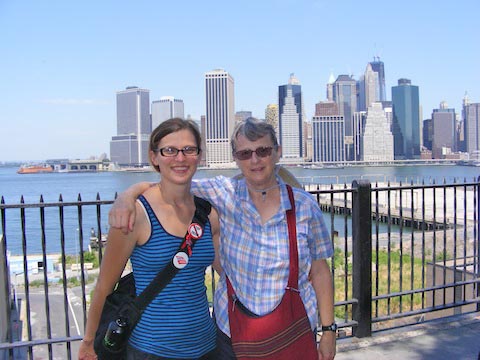
|
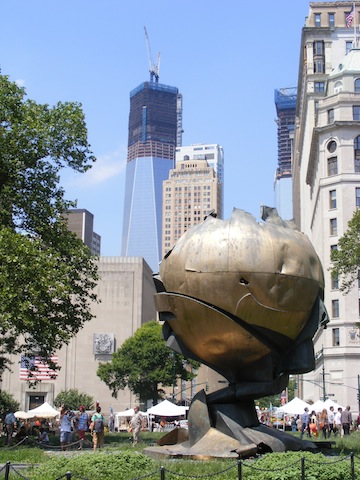
|
From New York, we headed west, spending one night in mid Pennsylvania and
then stopping near Cleveland, Ohio, to see the
Cuyahoga Valley National Park
and to recover from the fast pace of life in New York.

This park had been created in 1974. We had driven across it for decades and never noticed
it was there until last year.
The heart of the park is the Cuyahoga River and the Towpath Trail paralleling it.
The towpath had been part of the Ohio & Erie Canal. Branching off the Towpath Trail are
trails and roads to various attractions to see and experience. As a new and relatively urban
park, it is rather amorphous and at first we had trouble locating it.
We hiked trails on two days.
We saw peregrine falcons, a red-tailed hawk, a great blue heron rookery, painted turtles, a muskrat,
wood ducks, wood swallows, frogs and other birds and wild life.
It was relaxing.
Gail on the Towpath Trail north of the Boston Store Visitor Center
|
A peregrine falcon on a bridge support
near mile 177 of the Ohio Turnpike
|
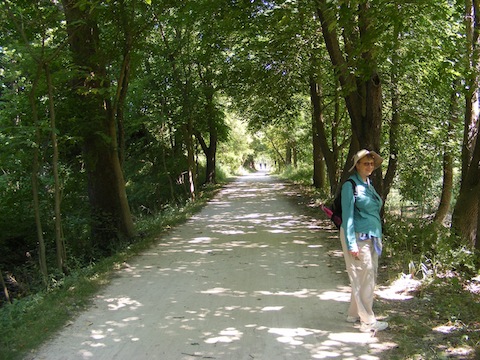
|
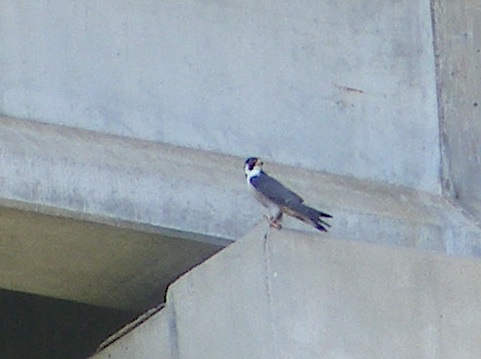
|
Brandywine Falls
60 feet high, but with only a trickle of water
|

|
After two days at the Cuyahoga Valley National Park, we headed north. After an
overnight stop in the Michigan's Lower Peninsula, we reached our next destination,
the
Seney National Wildlife Refuge
at Germfask in the Upper Peninsula. The refuge was
created in 1935 by Franklin Roosevelt and built by the Civilian Conservation Corp.
It provides a vast area of managed wetlands and highland forests where migrating
birds have a safe harbor and where animals like otters, beaver and resident birds
can thrive. Seney has a large population of trumpeter swans, first introduced here
in the early 1990s. The staff here pioneered techniques in rearing sandhill cranes
that were used to help bring whooping cranes back from the edge of extinction.
We visited Seney before in
May 2005.
This time we enjoyed seeing the old sights
and hiking new trails. We saw the swans, loons, ospreys and an eagle. We also
saw otters and a beaver. Not so pleasantly, black flies attacked us so we bought
nets to fit over our hats to protect our heads from them.
Nature trail at the wildlife refuge
|
A pair of trumpeter swans
|

|

|
Loon seen in the evening
|
Gail wearing one of our anti-fly nets
|

|

|
|
From Seney, we headed to
Bewabic
State Park in Michigan's Iron County, where we
stayed for three weeks.
Joey, our grandson, had sent us Flat Stanley, the hero of a series of books,
during the school year. He asked us to take photos of Flat Stanley where we
lived and send the pictures for him to share with his class. We did, and we also
took Flat Stanley to Germany and on this trip. While Flat Stanley was getting
his picture taken at Bewabic Park, a woman driving past stopped to talk with us
because her daughter had shouted out, "There's Flat Stanley!"
While in Iron County, we had many activities. We swam in the park, hiked in the
forests, toured the County Courthouse and museums, kayaked on the Michigamme River,
attended performances by the folk song duo
White Water,
and of the musical
"Always ... Patsy Kline"
in the building where Al attended high school,
ate and drank at a Wine and Cheese benefit for the Iron County Historical Museum,
and more. Back at the park we visited the beach, listened to the liquid notes of the
hermit thrushes
and read mysteries. Lacking a newspaper, we often got our news from Morning Edition
on WNMU FM 90.1.
We scheduled this time in Michigan in order to attend Al's 50th anniversary high school
reunion. We participated in a get together at Ottawa Lake, a tour of the Iron
County museum led by classmate Larry and the banquet at
Alice's
Restaurant (no, not the one in the song!).
Al really enjoyed meeting and talking with
classmates and friends, some of whom he had not seen in 50 years.
During the week following the reunion Al gave a presentation on
black holes,
dark matter and dark energy
at the museum. It was attended by more than 60 people.
|

|
Flat Stanley (and Al) at the entrance to Bewabic State Park
|
Al at the Iron County Courthouse in Crystal Falls, MI
|

|
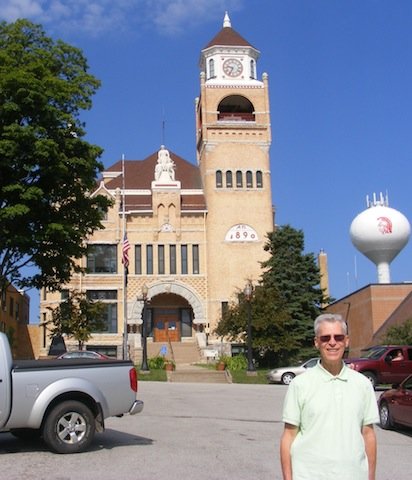
|
Gail in her kayak on the Michigamme River
|
Raspberries on a trail near Scott Lake
|

|
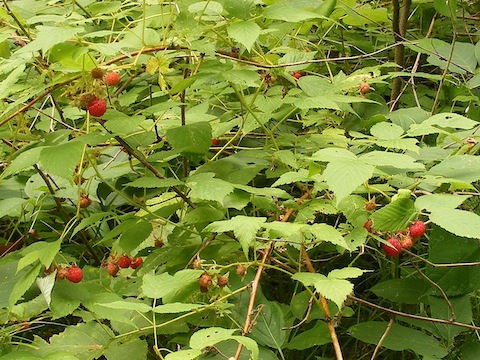
|
Al with some of his classmates at Ottawa Lake
Photo courtesy of Dennis Kried
|
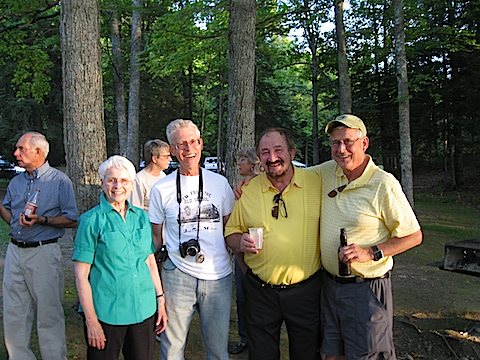
|
After Iron County, we headed west to the north shore region of Minnesota,
where we got together with Jane, who was Gail's college roommate and
the bride's maid at our wedding 38 years earlier,
and Jane's sister-in-law Pat. With them we visited three of Minnesota's state parks by
Lake Superior - Gooseberry Falls, Tettegouche and Temperance River. Al looked for
gooseberries in Gooseberry Falls State Park, but only found one bush. We did find
a number of bushes of thimbleberries,
and shared their sweet and tart fruit with
Jane and Pat. The scenery in these parks was terrific and the hiking
trails very enjoyable.
Gail, Pat and Jane at High Falls in Tettegouche State Park
|
Some thimbleberries in Gooseberry Falls State Park
|
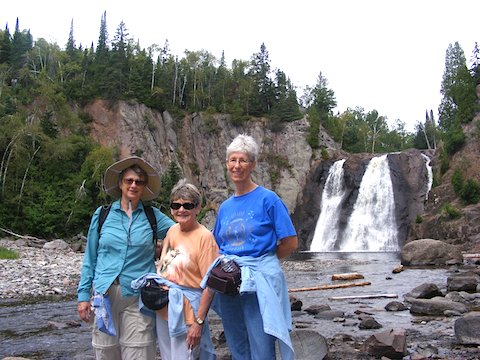
|
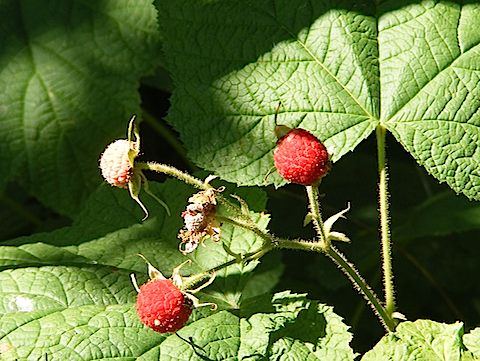
|
Lower gorge and some falls on the Temperance River
|
Waves breaking on the rocky shore near the mouth of the Cross River
|

|

|
Next we went to happy land, the Happy Land RV Park in Thunder Bay, Ontario, that is. We chose
to visit Thunder Bay because Gail's father had been born here and spent his first three years here.
Thanks to the old city directories in the public library, we learned a little about where
he lived. We were able to drive the location of the last place where he lived on Dease
Street, but there was nothing there now but a two-car garage. The street there was
narrow, about the width of an alley.
We also enjoyed ourselves visiting the Fort William
Historical Park, Kakabeka Falls
and Mount McKay. The Historical Park
is a re-creation of the 1815 fur trading center with re-enactments of daily chores and
special events. We ate Indian bread, helped paddle a birch-bark trading canoe on the
Kaministiquia River and watched the ceremony for the arrival of a trading party from
the interior among other things.
The Kakabeka Falls on
the Kaministiquia River is about 130 feet high, and an impressive amount of water
flows over it. The flow would be even greater, but much water is diverted upstream
to run a hydro-electric plant. Gail and I hiked over 8 kilometers of trails in the
park, and saw a bald eagle.
The Information Center on the border
|
“Voyageurs” approaching Fort William
|
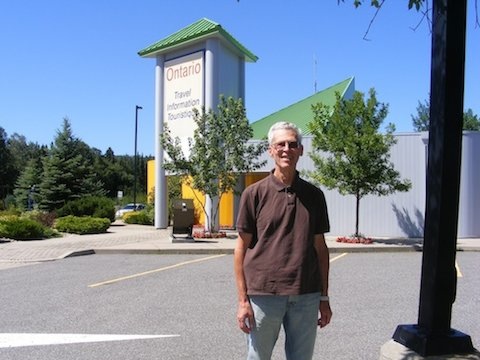
|

|
Kakabeka Falls from a distance
|
Us at Kakabeka Falls
|
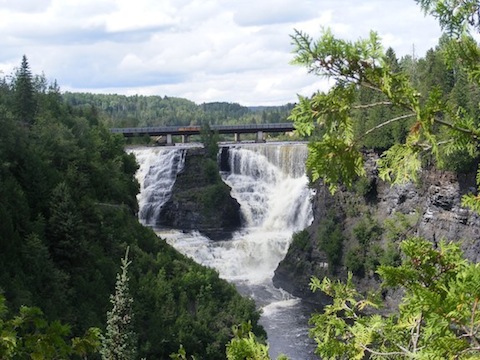
|

|
Cliffs on Mount McKay
|
|
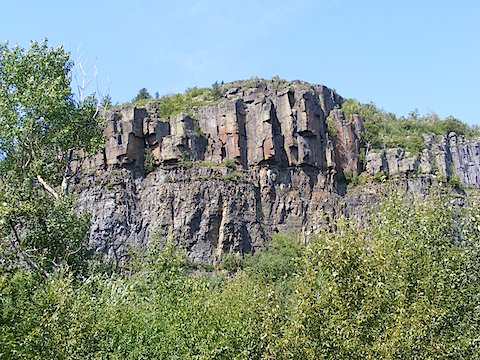
|
Mount McKay
is a mesa located across the Kaministiquia River south of Thunder Bay.
It stands about 900 feet above the level of Lake Superior. There is an observation
site maintained by the Ojibawa people about halfway up. We drove to observation site
and then climbed the “easy” trail to the summit off to the side of these cliffs.
The most of the trail was reasonable, but during the last 100 feet or so, we scrambled up
a very steep slope over large boulders. The view was great.
|
|
|
Kayaking on Thunder Lake
|
|
We chose Kenora, Ontario,
as our next destination because Al's father had been born there.
Heading west toward Kenora, we stopped for a day at Aaron Provincial Park
near Dryden. We hiked most of the park's trails and roads, paddled kayaks
on Thunder Lake, and saw one loon and many myrtle warblers. We also tasted
a bunchberry.
We'd often seen these red berries on the forest floor, but
had assumed they were poisonous. They are not, but have a very mild flavor.
The drive along the TransCanada Highway, Hwy 17, was pleasant. Although
it is the principal east-west road in Canada, it is mostly two lane with little
traffic and
with passing lanes every 15 kilometers or so (up here we speak in kilometers,
not miles). Between the little settlement of Vermillion Falls and Kenora,
it seemed that every turn in the road revealed a new lake, always with rocky
shores and often overlooked by cliffs.
|
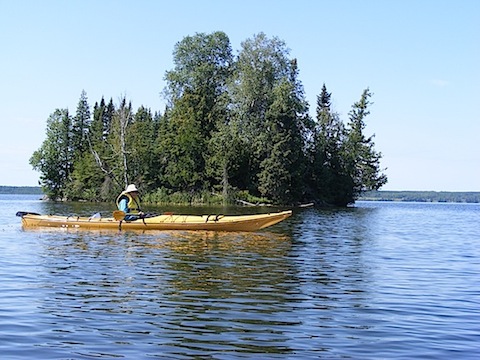
|
The clerk at the campground where we are stayed in Kenora gave us a site where we could have
WiFi access. Unfortunately, this required that Al back the trailer onto a narrow platform.
While trying to get the trailer aligned on the platform he neglected to watch where the
truck was going. Oops! He lost the rear tire of the truck off the edge of the platform.
A host of interested men soon gathered. One had a 20-ton jack and claimed to have gotten
snowplows out similar situations. It turns out that after a lot of effort, his technique
worked and we were back on solid ground with no injuries to anyone. Whew!
Our visit got better from there. Kenora is on the shore of
Lake of the Woods.
Lake of the Woods is 68 miles long and 59 miles wide, but it is filled with
large peninsulas and more than 14,500 islands. It would be easy to go out
on the lake and get lost.
We took a
cruise on the MS Kenora out among the islands and the captain did not let us
get lost.
We saw islands, cottages, powerboats, float planes, kayaks and even paddle boards, but
surprisingly no sailboats.
On the shore, we saw buildings that Al's grandfather passed through when he was here and
we visited the cemetery where Al's great-grandmother is buried.
While we were there, one of the big items on the regional radio news was about a
man whose foot was bitten by a 40-inch muskellunge (muskie). The man was dangling
his feet in the water off a dock in the park where we were camping when the fish
came along. The man jerked his foot up and lifted the fish a foot out of the
water, but then it got away.
Oops!
|
1899 train station where Al's grandfather arrived in Kenora in 1909
|

|

|
Gail on the MS Kenora with some of the 14,500 islands behind her
|
Kenora seen from the Lake of the Woods
|
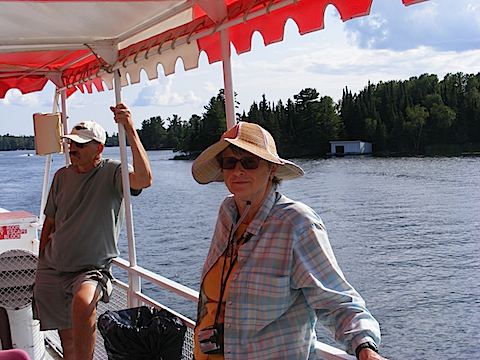
|

|
From Kenora we headed south, crossing the border to International Falls, MN, and
nearly hitting a bald eagle that had been feasting on road kill by The King's Highway 71.
Our goal was to see some of Voyageurs National Park.
Boosters of travelling by RV talk about how you can take your time, stop where you want,
see the country at your leisure. We did that. If we wanted, we'd camp somewhere that was
not on the original plan or we'd extend our stay somewhere by a day or two. But the
reality is that during the camping season, the campgrounds fill up on weekends and it
may be difficult to find somewhere to stay if you have not made reservations long in
advance.
We ran into that situation with our visit to Voyageurs National Park. We had to camp
in a small campground in the city rather than the lakeside resort we had hoped for.
But this turned out well. We had easy access to supermarkets and to the library where
we could get onto the internet. We were close to the Park's Rainy Lake Visitor Center
where we met a stuffed moose and took a cruise on Rainy Lake where we saw many
bald eagles. And we still could
get to the trails that we like to hike.
Gail with the only moose we've seen in decades -
stuffed
|
Rainy Lake has rocky islands like Lake of the Woods
just not nearly as many
|

|
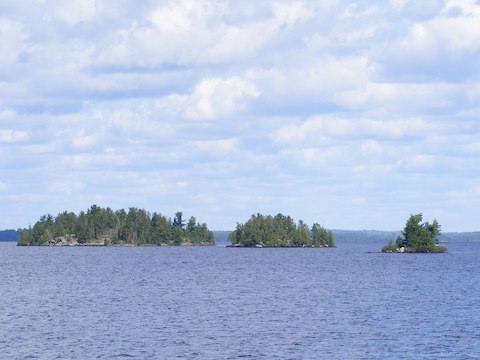
|
One of the eagles seen during our cruise on Rainy Lake
|
Kabetogama Lake seen from the Blind Ash Bay Trail
|
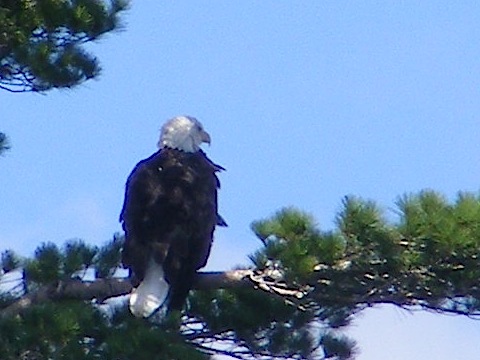
|

|
|
|
Willow River falls. You can see people wading on a ledge
halfway up the left side of the photograph.
|
|
From International Falls, we headed further south, stopping at the Willow River State
Park near Hudson, Wisconsin. There we enjoyed another waterfall. We also visited with
Gail's brother Guy and Guy's family and with Gail's former boss Bill and Bill's wife Julie.
|
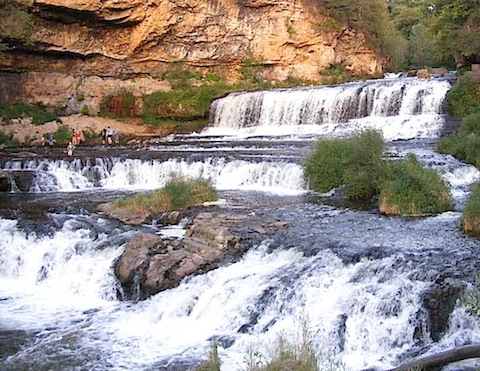
|
The third pillar of our trip was the reunion of five classes from
the Genoa City School. We camped at the Happy Acres Kampground, which is
relatively near to Genoa City and has internet access. (Internet access was
important to us for planning future travel and for keeping in touch with family.)
The reunion covered two days, beginning with a pizza meal Saturday afternoon, followed
by an evening social the same day and by a picnic on Sunday. It rained on Sunday
but we were in a shelter and nobody's spirits were dampened. Everyone had lots of
questions and stories to share.
In addition to the reunion, we had time to hike in the Richard Bong State
Recreation Area
(named after a WW2 flying ace) and in the Kettle Morraine State Forest - South.
Genoa City in southeastern Wisconsin
|
Gail with some of her 1959 classmates
|
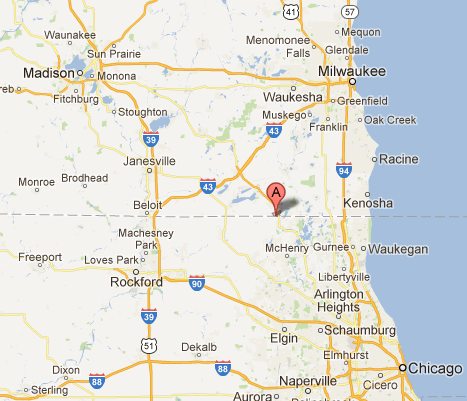
|
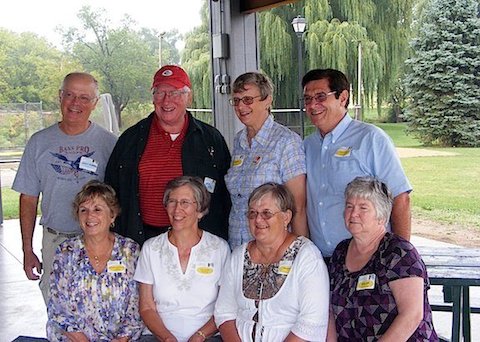
|
A red-tailed hawk in the Bong State Recreation Area
|
|

|
|
From Genoa City, we moved to Madison, WI. Many things happen
in Madison and we took advantage of them.
We hiked in nearby
state and county parks, and in University of Wisconsin's
Arboretum.
We helped to recover usable food to be distributed to food banks at
Second Harvest.
We helped to weed and plant in the Arboretum, hoping that during our
weeding we weren't pulling the last specimen of some endangered plant.
We laughed at a performance by comedienne Paula
Poundstone, a regular panelist
on Wait Wait… Don't Tell Me!.
We visited the International Crane Foundation,
where they are helping save endangered crane
populations, including North America's whooping crane.
We heard a concert by the Madison Symphony
in the Overture Center,
sitting in the second row thanks for our friend Maija's connections.
We enjoyed food, music and dance at a Thai Festival.
We alternatively were puzzled, amused and impressed at a performance of
44 Plays for 44 Presidents.
We attended the
Fighting Bob Fest, where we heard speeches by
environmentalist Bill McKibben, former TV host Phil Donahue and Green presidential
candidate Jill Stein. Mckibben convinced us that one of our goals should be to
be arrested protesting against the energy companies and lawmakers who are acting in such
a way as to lead to climate change.
We got our news here from Morning Edition on WERN FM 88.7.
Maija and Gail under the bridge in
Wisconsin's Natural Bridge State Park
|
Excavations provided evidence that this rock shelter
at Natural Bridge State Park was inhabited by humans 12,000 years ago
|
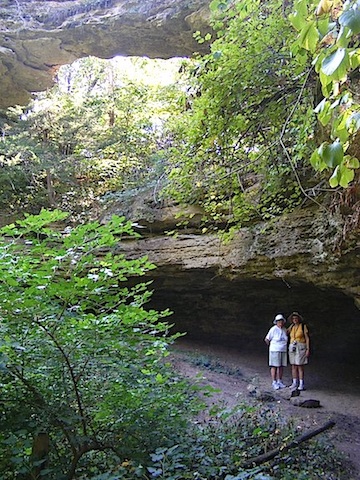
|

|
Flat Stanley (and Gail) at the Wisconsin State Capitol
|
Saturday morning farmers market in Madison
A few of the booths and some of the crowds
|

|

|
Gail and Susan, our supervisor, pulling weeds
in the Arboretum
|
Two Whooping Cranes at the
International Crane Foundation near Baraboo, WI
|

|
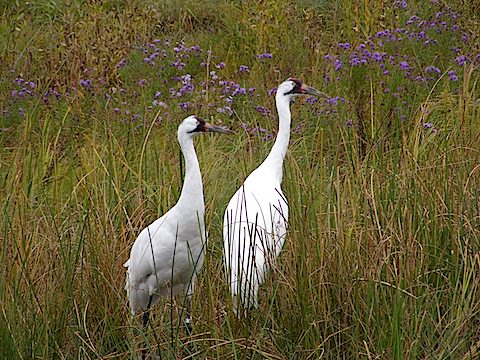
|
Image of the gilt Thai Pavilion in its
reflection pool at Olbrich Park, Madison, WI
|
Thai dancers with drums at the Thai Pavilion
|

|

|
The last pillar of our trip was the weekend get together with the MinnClan. It was
during the plague of the boxelder bugs. We gathered at the
Cooksville Farmhouse Inn
in historic, though small, Cooksville, Wisconsin. Bob and Ann came from St. Louis,
Bill and Julie from St. Paul, Bob and Lolly from Shawano, WI, Maija from Madison and
we from our temporary location at the Lake Farm Park in Dane County.
Local resident Larry and our host Martha gave us a
tour of the mid 19th century buildings in Cooksville.
Some of us
attended a live broadcast of
Michael Feldman's Whad'ya Know in Madison and
others attended a performance of Ole and Lena's Wedding in Stoughton. We enjoyed a
campfire Saturday evening and tried to remember songs to sing around it. And, of course,
we ate and drank well.
Larry and Martha lead the MinnClaners on a tour of
buildings in the historic district of Cooksville
|
Bob, Gail, Julie and Ann at Saturday night's campfire
|

|

|
On the last weekend of our travels, the refrigerator of the Moving House stopped
working. Al suspects it had something to do with the plague of boxelder bugs.
All the same, it was time to turn towards our Maryland home and prepare to celebrate
granddaughter Abby's second birthday!
In our journey, we were out for 98 days during which we
pulled our Moving House nearly 3,940 miles and
drove our truck an additional 2,570 miles in local travel.
We visited two national parks and fourteen state and provincial parks.
We hiked many miles of trails, some wide and paved, others partially hidden among
bushes and blackberry thorns.
It was good to arrive at our home
with its dishwasher and compost barrel, but we miss the chatter of the
sandhill cranes flying overhead, the lonesome-sounding calls of the loon in the morning
and the liquid calls of the hermit thrushes. We also miss all the people we
visited with during the trip.
















































